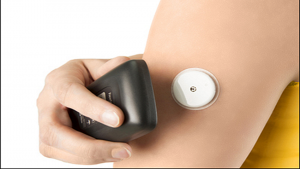Blood Glucose Monitoring

Advances in Blood Glucose Monitoring
Blood glucose monitoring is a way of testing the concentration of glucose in the blood (glycemia). You can determine if you have low blood sugar (hypoglycemia) by using a blood glucose meter. Hypoglycemia is defined as blood sugar below 70 milligrams per deciliter (mg/dL), or 3.9 millimoles per liter (mmol/L).
Traditionally, you prick your finger, put a drop of blood on a test strip, and insert it into a blood glucose meter. The glucose in your blood reacts with the chemicals in the strip. There have been new advances in continuous glucose monitoring. Some people use a sensor inserted under the skin, called a continuous glucose monitor (CGM), to check blood sugar levels. Others use flash glucose monitoring.
Flash Glucose Monitoring

Flash glucose monitoring technology allows patients to get a blood glucose reading without sticking their finger.
It consists of a touchscreen reader device that displays data and trend info and a sensor patch that you wear on the upper arm.
Flash glucose monitoring works by measuring the amount of glucose in the fluid that surrounds your cells (interstitial fluid) through the sensor patch. It records your blood sugar levels throughout the day, and stores the data (your ambulatory glucose profile) to help you and your diabetes healthcare team make decisions on treatments.
Advantages of flash glucose monitoring include fewer finger-prick checks and the ability to see trends, like when your sugar levels are starting to rise or drop. Disadvantages include not being able to set an alarm for low or high sugar levels, making it harder to recognize hypoglycemia. Some patients dislike wearing the sensor or get overwhelmed by the data.
Talk to an endocrinologist to learn more about your options for blood glucose monitoring.

Lori Berard RN CDE
Lori Berard is Diabetes Educator with an expertise in diabetes education, management and clinical research. As a certified diabetes educator,…

